RAF Early Jets - Part 1
|
|
Founded - 1 April 1918
Country - United Kingdom
Size - 41,440 personnel, 1,109 aircraft[1]
Part of - British Armed Forces
Air Staff Offices - MOD Main Building, Whitehall
Motto - Latin: Per Ardua ad Astra, "Through Struggle to the Stars"[2]
March - Royal Air Force March Past
Current Aircraft Flown
Attack - Harrier GR7, Harrier GR9, Tornado GR4,
Electronic warfare - Sentry
Helicopter - Chinook, Merlin, Puma, Sea King, Griffin HAR2
Interceptor - Tornado F3, Typhoon
Patrol - Nimrod MR2
Reconnaissance - Islander, Nimrod R.1, Sentinel R1, Reaper, Tornado GR4A
Trainer - Dominie, Hawk, King Air, Squirrel, Tucano, Tutor, Vigilant, Viking
Transport - C-17, Hercules C3, Hercules C4 & C5, Tristar, VC10
The Royal Air Force (RAF) is the United Kingdom's air force, the oldest independent air force in the world.[3] [nb 1] Formed on 1 April 1918,[5] the RAF has taken a significant role in British military history ever since, playing a large part in World War II and in more recent conflicts.
The RAF operates almost 1,109 aircraft and, as of 31 March 2009, had a projected trained strength of 41,440 regular personnel[6], making it the largest air force in the European Union. The majority of the RAF's aircraft and personnel are based in the UK with many others serving on operations (principally Afghanistan, the Middle East and the Balkans) or at long-established overseas bases (Ascension Island, Canada, Cyprus, Diego Garcia, Gibraltar, the Falkland Islands and Germany).
Mission
The RAF's mission is to support the objectives of the British Ministry of Defence (MoD), which are to "provide the capabilities needed: to ensure the security and defence of the United Kingdom and overseas territories, including against terrorism; to support the Government’s foreign policy objectives particularly in promoting international peace and security."[7]
The RAF's own mission statement reads as thus, to provide (paraphrase) "An agile, adaptable and capable Air Force that, person for person, is second to none, and that makes a decisive air power contribution in support of the UK Defence Mission."[8]
The above statement goes hand in hand with the RAF's definition of air power, the concept that guides the RAF strategy. Air Power is defined as: "The ability to project military force in air or space by or from a platform or missile operating above the surface of the earth. Air platforms are defined as any aircraft, helicopter or unmanned air vehicle."[9] Although the RAF is the principal British air power arm, the Royal Navy's Fleet Air Arm and the British Army's Army Air Corps also deliver air power which is integrated into the maritime and land environments respectively.
History
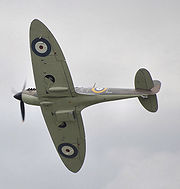 Picture:
Distinctive shape of the Spitfire which played a part in the Battle of Britain.
Picture:
Distinctive shape of the Spitfire which played a part in the Battle of Britain.
While the British were not the first to make use of heavier-than-air military aircraft, the RAF is the world's oldest independent air force.[3] It was founded on 1 April 1918, during the First World War, by the amalgamation of the Royal Flying Corps and the Royal Naval Air Service. After the war, the service was drastically cut and its inter-war years were relatively quiet, with the RAF taking responsibility for the control of Iraq and executing a number of minor actions in other parts of the British Empire.
The RAF underwent rapid expansion prior to and during the Second World War. Under the British Commonwealth Air Training Plan of December 1939, the air forces of British Commonwealth countries trained and formed "Article XV squadrons" for service with RAF formations. Many individual personnel from these countries, and exiles from occupied Europe, also served with RAF squadrons.
In the Battle of Britain, in the late summer of 1940, the RAF (Helped by multinational i.e. Polish, Czechoslovakian pilots and ground personnel) defended the skies over Britain against the German Luftwaffe, helping foil Hitler's plans for an invasion of the United Kingdom, and prompting Prime Minister Winston Churchill to say in the House of Commons on 20 August, "Never in the field of human conflict was so much owed by so many to so few".[11]
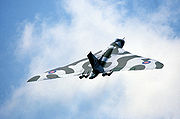 Picture:
The Avro Vulcan was a strategic bomber used during the Cold War to carry conventional and nuclear bombs.
Picture:
The Avro Vulcan was a strategic bomber used during the Cold War to carry conventional and nuclear bombs.
The largest RAF effort during the war was the strategic bombing campaign against Germany by Bomber Command. While RAF bombing of Germany began almost immediately upon the outbreak of war, under the leadership of Air Chief Marshal Harris, these attacks became increasingly devastating from 1942 onward as new technology and greater numbers of superior aircraft became available. The RAF adopted night-time area bombing on German cities such as Hamburg and Dresden, and developed precision bombing techniques for specific operations, such as the "Dambusters" raid by No. 617 Squadron,[12] or the Amiens prison raid known as Operation Jericho.
During the Cold War years the main role of the RAF was the defence of the continent of Europe against potential attack by the Soviet Union, including holding the United Kingdom's nuclear deterrent for a number of years. After the Cold War, the RAF was involved in several large scale operations, including the Kosovo War, the 2001 invasion of Afghanistan and the 2003 invasion of Iraq.
The RAF celebrated its 90th birthday with a flypast of the Red Arrows and four Typhoons over many RAF Stations and Central London on 1 April 2008.[13]
The Royal Air Force Museum is a museum dedicated to the history of aviation, and the Royal Air Force in particular. It is based at two sites, Colindale
in north London, and Cosford, Shropshire.
Royal Air Force
The professional head of the RAF is the Chief of the Air Staff (CAS), Air Chief Marshal Sir Stephen Dalton. The CAS heads the Air Force Board, which is a committee of the Defence Council. The Air Force Board is the management board of the RAF and consists of the Commander-in-Chief of Air Command (currently Air Chief Marshal Sir Chris Moran), together with several other high ranking officers. The CAS also has a deputy known as the Assistant Chief of the Air Staff (ACAS); this post is held by Air Vice-Marshal T M Anderson.[14]
Aircraft
British military aircraft designations generally comprise a type name followed by a mark number which includes an alphabetical rôle prefix. For example, the Tornado F3 is designated as a fighter by the 'F', and is the third variant of the type to be produced.
Strike, attack and offensive support aircraft

The mainstay of the offensive support fleet is the Tornado GR4. This supersonic aircraft can carry a wide range of weaponry, including Storm Shadow
cruise missiles, laser-guided bombs and the ALARM anti-radar missile.
The Tornado is supplemented by the Harrier GR7/GR7A which is used in the strike and close air support roles, and to counter enemy air defences. The Harrier is being upgraded to GR9/GR9A standard with newer systems and more powerful Rolls Royce Pegasus engines. The Harrier GR9 was formally accepted into RAF service in late September 2006.
 The Eurofighter Typhoon FGR4, has from June 2008 achieved the required standard for multi-role operational deployment.[18]
The Eurofighter Typhoon FGR4, has from June 2008 achieved the required standard for multi-role operational deployment.[18]
Air defence and airborne early warning aircraft
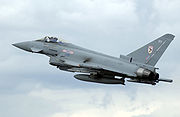 The Panavia Tornado F3 and Eurofighter Typhoon F2 are the RAF's air defence fighter aircraft, based at RAF Leuchars and RAF Coningsby respectively.
Their task is to defend the UK’s airspace. In October 2007 it was announced that RAF Boscombe Down will become one of a number of quick reaction
alert airbase from early 2008, offering around the clock fighter coverage for the South and South West of UK airspace when a direct threat has been identified,
otherwise the aircraft will be based at RAF Leuchars and Coningsby as described above.[19]
The Panavia Tornado F3 and Eurofighter Typhoon F2 are the RAF's air defence fighter aircraft, based at RAF Leuchars and RAF Coningsby respectively.
Their task is to defend the UK’s airspace. In October 2007 it was announced that RAF Boscombe Down will become one of a number of quick reaction
alert airbase from early 2008, offering around the clock fighter coverage for the South and South West of UK airspace when a direct threat has been identified,
otherwise the aircraft will be based at RAF Leuchars and Coningsby as described above.[19]
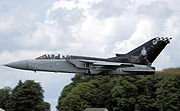 The Tornado, in service in the air defence role since the late 1980s, is being replaced by the Eurofighter Typhoon F2, based at RAF Coningsby. The RAF's
second operational Typhoon unit, 11 Sqn, reformed on 29 March 2007, joining 3 Sqn, also based at RAF Coningsby. The Tornado F3s at RAF Leuchars will
gradually be phased out and replaced with Typhoons, which will also be based at RAF Leuchars.
The Tornado, in service in the air defence role since the late 1980s, is being replaced by the Eurofighter Typhoon F2, based at RAF Coningsby. The RAF's
second operational Typhoon unit, 11 Sqn, reformed on 29 March 2007, joining 3 Sqn, also based at RAF Coningsby. The Tornado F3s at RAF Leuchars will
gradually be phased out and replaced with Typhoons, which will also be based at RAF Leuchars.
The Sentry AEW1, based at RAF Waddington , provides airborne early warning to detect incoming enemy aircraft and to co-ordinate the aerial battlefield. Both the Sentry and the Tornado F3 have been involved in recent operations including over Iraq and the Balkans.
 Reconnaissance aircraft
Reconnaissance aircraft
The Tornado GR4A is fitted with cameras and sensors in the visual, infra-red and radar ranges of the spectrum.
 The Nimrod R1 provides electronic and signals intelligence.
The Nimrod R1 provides electronic and signals intelligence.
The new Sentinel R1 (also known as ASTOR – Airborne STand-Off Radar) provides a ground radar-surveillance platform based on the Bombardier Global
Express long range business jet. These will be supplemented in 2009 by four Beechcraft Shadow R1 aircraft equipped for the ISTAR role over Afghanistan.[20]
These will be supplemented in 2009 by four Beechcraft Shadow R1 aircraft equipped for the ISTAR role over Afghanistan.[20]
.jpg) A pair of MQ-9 Reaper Unmanned aerial vehicles have been purchased to support operations in Iraq and Afghanistan. They are operated by No. 39 Squadron
RAF. A third MQ-9 is in the process of being purchased.[21]
A pair of MQ-9 Reaper Unmanned aerial vehicles have been purchased to support operations in Iraq and Afghanistan. They are operated by No. 39 Squadron
RAF. A third MQ-9 is in the process of being purchased.[21]
Support helicopters
An important part of the work of the RAF is to support the British Army by ferrying troops and equipment at the battlefield. However, RAF helicopters are also used in a variety of other roles, including support of RAF ground units and heavy-lift support for the Royal Marines. The support helicopters are organised into the tri-service Joint Helicopter Command (JHC), along with helicopters of the British Army and Royal Navy. The only helicopters not coordinated by the JHC are the search and rescue helicopters of the RAF and RN, and those RN helicopters that are normally based onboard a ship such as a destroyer.
The large twin-rotor Chinook HC2/HC2A, based at RAF Odiham provides heavy-lift support and is supported by the Merlin HC3 and the smaller Puma HC1 medium-lift helicopters, based at RAF Benson and RAF Aldergrove.
It was announced in March 2007 that the RAF will take delivery of six additional Merlins. The aircraft were originally ordered by Denmark and six new aircraft will be built for Denmark. It was also announced that eight Chinook HC3s, that are in storage, will be modified for the battlefield support role.
Maritime patrol
The Nimrod MR2's primary role is that of Anti-Submarine Warfare and Anti-Surface Unit Warfare. The Nimrod MR2 is additionally used in a Search and Rescue
role, where its long range and communications facilities allow it to co-ordinate rescues by acting as a link between rescue helicopters, ships and shore
bases. It can also drop pods containing life rafts and survival supplies to people in the sea.
Transport and air-to-air refuelling aircraft
Having replaced the former Queen's Flight in 1995, 32 (The Royal) Squadron uses the BAe 125 CC3, Agusta A109 and BAe 146 CC2 in the VIP transport role, based at RAF Northolt, just west of London.
More routine, strategic airlift transport tasks are carried out by the Tristars and VC10s based at RAF Brize Norton, for passengers and cargo, and for air-to-air refuelling of other aircraft.
Shorter range, tactical-airlift transport is provided by the Hercules, the fleet including both older C-130K (Hercules C1/C3) and newer C-130J (Hercules C4/C5) variants, based at RAF Lyneham in Wiltshire.
The RAF has leased four C-17 Globemaster IIIs from Boeing to provide a heavy, strategic airlift capability. These will be purchased, as well a fifth C-17 delivered on 7 April 2008. A sixth aircraft, which the MoD announced would bolster operations in Iraq and Afghanistan, was delivered on 8 June 2008. The new aircraft have entered frontline use within days rather than weeks. The MoD has said "there is a stated departmental requirement for eight" C-17s which means the next two would be delivered before mid-2009 when the Globemaster production line may be closed.
Search and rescue aircraft
Three squadrons of helicopters exist with the primary role of military search and rescue; the rescuing of aircrew who have ejected or crash-landed their aircraft. These are 22 Sqn and 202 Sqn with the Sea King HAR.3/HAR3A in the UK and 84 Sqn with the Griffin HAR2 in Cyprus.
Although established with a primary role of military search and rescue, most of their operational missions are spent in their secondary role of conducting civil search and rescue; that is, the rescue of civilians from at sea, on mountains and other locations.
Both rescue roles are shared with the Sea King helicopters of the Royal Navy's Fleet Air Arm, while the civil search and rescue role is also shared with the helicopters of HM Coastguard.
The Operational Conversion Unit is 203 (Reserve) Squadron RAF based at RAF Valley equipped with the Sea King HAR3.
The related Royal Air Force Mountain Rescue Service comprises four teams of trained mountaineers stationed in the mainland United Kingdom, first established in 1943.
Training aircraft
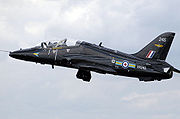 Elementary flying training is conducted on the Tutor T1. The Tutor is also used, along with the Viking T1 and Vigilant T1 gliders, to provide air experience
training and basic pilot training for air cadets.
Elementary flying training is conducted on the Tutor T1. The Tutor is also used, along with the Viking T1 and Vigilant T1 gliders, to provide air experience
training and basic pilot training for air cadets.
Basic pilot training for fixed-wing and helicopter pilots is provided on the Tucano T1 and Squirrel HT1, while weapon systems officer and weapon systems operator training is conducted in the Dominie T1.
Advanced flying training for fast-jet, helicopter and multi-engine pilots is provided using the Hawk T1, Griffin HT1 and B200 King Air respectively. At the more advanced stage in training, variants of front-line aircraft have been adapted for operational conversion of trained pilots; these include the Harrier T10 and Typhoon T1.
Future aircraft
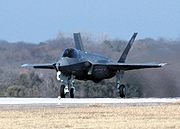 The RAF is planning for the introduction of new aircraft. These include:
The RAF is planning for the introduction of new aircraft. These include:
-The Nimrod MR2 fleet is to be replaced by nine aircraft rebuilt to Nimrod MRA4 standard. Originally scheduled to be in service in 2003, these aircraft
are now expected to enter service in late 2010.
-The Airbus A400M, of which 25 are to be used to replace the remaining Hercules C-130Ks.[22]
-An enhanced version of the Chinook, the HC3, with improved avionics and increased range for special forces missions, was ordered in 1995. Due to technical
and project management problems, these aircraft have not yet entered service, they are still in storage, but are now due to be downgraded to Support
Helicopter configuration and deployed by 2009.
-The Hawk T2 will replace the existing Hawks in service; the newer model being more similar in equipment and performance to modern front line aircraft.
-The ageing aerial refuelling fleet of VC10s and Tristars will be replaced with the Airbus A330 MRTT under the Future Strategic Tanker Aircraft programme.
-The F-35B Lightning II will replace the Harrier GR7 and GR9 under the Joint Combat Aircraft programme.
-Project Taranis aiming to provide further Strategic Unmanned Aerial Vehicle services in both ground attack and reconnaissance roles.
-A possible sale or lease of three former United States Air Force KC-135R aircraft, converted to RC-135V/W Rivet Joint standard, has been notified to
the United States Congress by the American Defense Security Cooperation Agency.[23]
References
1. http://www.publications.parliament.uk/pa/cm200708/cmhansrd/cm080703/text/80703w0006.htm#08070366002709
2. a b RAF – Frequently Asked Questions
3. a b Royal Air Force 90th Anniversery History of the RAF
4. "FINNISH AIR FORCE AIRCRAFT HISTORY TIMELINE". Pentti Perttula. April 8 2008. http://www.saunalahti.fi/~ambush/faf/summary.html. Retrieved
29 August 2009.
5. the.historychannel.co.uk History Channel – 1 April founding of RAF
6. RAF new structure as of 31 March 2008
7. Defence Analytical Services Agency The MOD Mission
8. RAF website
9. RAF website
10. Tornados Bound for Kandahar, Air Forces Monthly, August 2008 issue, p. 8.
11. The Churchill Centre – Speeches & Quotes
12. Paul Brickhill, The Dambusters
13. BBC, Your Pictures: RAF Flypast
14. "Assistant Chief of the Air Staff (ACAS)". Royal Air Force web site. Royal Air Force. 2008. http://www.raf.mod.uk/structure/acas.cfm. Retrieved
2008-03-18.
15. www.raf.mod.uk 31 March 2006. Command Structure.
16. "Defence Personnel Totals, armedforces.co.uk". http://www.armedforces.co.uk/mod/listings/l0013.html.
17. BBC News Fly-past for Britain's oldest man
18. AirForcesMonthly.August 2008.p9
19. Air base in front line fully-armed – Salisbury Journal, Monday 29 October 2007
20. "UK converts King Air 350s into ISTAR platforms". www.defence-solutions.co.uk. 2009-01-13. http://www.defence-solutions.co.uk/Public/News/news_view.aspx?articleid=52.
Retrieved 2009-02-16.
21. Air Forces Monthly, December 2007 issue, p.6.
22. Royal Air Force – A400M
23. United Kingdom - RC-135V/W Rivet Joint Aircraft
24. Cranwell Heraldry Part One: The Royal Air Force Badge – The Heraldry Society, September 2005
25. a b Air Ministry Orders A.666/49, 15 September 1949
26. It’s an albatross, it’s an eagle … it’s an eagle
Tags: world war ii documentary, world war two documentary, film documentary, documentary films, documentary dvd, documentary world war 2, world war 2 movie, world war 2 video, world war 2 dvd, world war ii dvd, world war ii video, world war ii films, world war 2 dvds, world war 2 documentaries, world war ii documentaries, world war two films
Living Warbirds: The best warbirds DVD series.
Source: WikiPedia